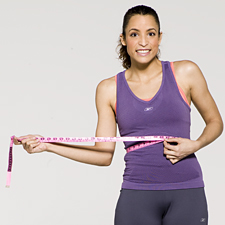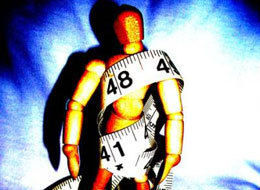
I found this helpful blog post from “Health.com” by Dorothy Foltz-Gray and Beth Dreher on finding your ideal weight. Here are the first two steps:
1. What’s your BMI?
How tall you are, obviously, has a lot to do with whether your weight is healthy–and that’s always frustrating for the vertically challenged. At, say, 150 pounds, your weight’s just right if you’re 5 feet 8 inches tall, on the high side of normal if you’re 5 feet 6 inches, considered overweight if you’re 5 feet 4 inches, and near obese at 5 feet. To figure out if your weight is healthy for your height, calculate your body mass index (BMI). BMI isn’t a perfect measure (see question 2 below), but it’s a great place to start your calculations.
Healthy-weight bonus: The higher your BMI, the higher your risk for diabetes. But lose just 7 percent of your body weight (that’s about 10 pounds for a 140-pound woman), and you can cut your risk by 60 percent.
2. What’s your build?
Line up 10 women who are all 5 feet 4 inches tall or who each weigh 150 pounds, and you’ll quickly see why height or weight alone–or even BMI–doesn’t always reflect what’s healthy. The differences in muscle strength, body shape, and frame size can be astounding.
If you’re muscular, your BMI can easily fall into the so-called overweight range because muscle weighs more than fat, says Steven Blair, professor of exercise at the University of South Carolina in Columbia. “By BMI classifications, most football players are obese, Arnold Schwarzenegger is obese, and Serena Williams is overweight. See other surprising celebrity BMIs. The categories of normal, overweight, and obese are useful for research but not always when it comes to the public.”
Consider your frame size, too. Insurance companies typically divide their weight charts into small-, medium-, and large-frame categories. At 5 feet 4 inches, wearing 1-inch heels, and fully clothed, what’s classified as a healthy weight can range from around 115 to 150 pounds, depending upon your frame. Based on your build, you and your doctor can decide if a too-high BMI is OK for your frame or musculature or if it’s a sign that you need to burn some fat–pronto.
Frame-size calculator: The distance between the two little bones on either side of your elbow is used to determine frame size. Hold up your arm at a 90-degree angle with your palm facing your face. Put the pointer finger of your other hand on the bone on one side and your thumb on the other. Then measure the distance between them. Frame sizes are for a women in the 5-foot-4 to 5-foot-7 range.
Distance between elbow bones:
2 2/8 inches and below–Small frame
2 3/8 inches to 2 5/8 inches–Medium frame
2 6/8 inches and above–Large frame

